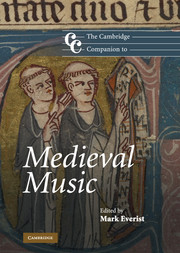Book contents
- Frontmatter
- Introduction
- Part I Repertory, styles and techniques
- Part II Topography
- Part III Themes, topics and trajectories
- 11 Music and liturgy
- 12 Vernacular poetry and music
- 13 Latin poetry and music
- 14 Compositional trajectories
- 15 Ecclesiastical foundations and secular institutions
- 16 Theory and notation
- 17 Music manuscripts
- 18 The geography of medieval music
- 19 Reception
- Notes
- Bibliography
- Index
13 - Latin poetry and music
from Part III - Themes, topics and trajectories
Published online by Cambridge University Press: 28 September 2011
- Frontmatter
- Introduction
- Part I Repertory, styles and techniques
- Part II Topography
- Part III Themes, topics and trajectories
- 11 Music and liturgy
- 12 Vernacular poetry and music
- 13 Latin poetry and music
- 14 Compositional trajectories
- 15 Ecclesiastical foundations and secular institutions
- 16 Theory and notation
- 17 Music manuscripts
- 18 The geography of medieval music
- 19 Reception
- Notes
- Bibliography
- Index
Summary
The Latin poetry set to music during the Middle Ages and discussed in this chapter may be divided into two main types, metra, based on syllabic quantity, and rhythmi (in the Middle Ages often spelt rithmi or the like), based on accent and syllable count, but from the fourteenth century often on the latter alone. Not regarded are psalms and other texts of like form such as the Te Deum, based on paired phrases of parallel or quasi-parallel but unregulated structure.
The term ‘verse’ will be used throughout as a synonym of ‘line’, not of ‘stanza’, though ‘verse-form’ will be used to accommodate both the measures of single verses and their combinations into stanzas as a single concept. To avoid confusion, only quantitative measures will be called ‘metres’.
It is on verse-forms that primary emphasis will be laid, the better to assist study of the relation, or lack of relation, between words and music. Some literary criticism will be offered, principally of motet texts, since these have been neglected by students of literature and only of late considered by musicologists. (This neglect is not only modern: the state of many texts in our manuscripts indicates that music copyists did not always take much interest in them; sometimes it was already a corrupt text that the composer set.)
- Type
- Chapter
- Information
- The Cambridge Companion to Medieval Music , pp. 225 - 240Publisher: Cambridge University PressPrint publication year: 2011
- 1
- Cited by



